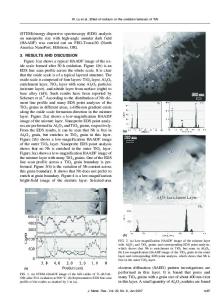The effect of grit blasting on the oxidation behavior of a platinum-modified nickel-aluminide coating
- PDF / 8,358,982 Bytes
- 12 Pages / 612 x 792 pts (letter) Page_size
- 51 Downloads / 331 Views
I. INTRODUCTION
COMMERCIAL thermal barrier coatings (TBCs) applied on the surface of turbine superalloys consist of an yttria-stabilized zirconia (YSZ) ceramic coating and an aluminum-rich metallic bond coat. The bond coat provides oxidation protection for the underlying superalloy by forming an adherent and slowly growing ␣-Al2O3 oxide scale. The platinum-modified nickel-aluminide, -(Ni,Pt)Al, is among the most oxidation-resistant bond coats. It is deposited by platinum electroplating followed by a low-Al-activity chemical vapor deposition (CVD) process.[1] A number of studies have been focused on the oxidation behavior of such coatings, in particular with respect to the role of surface imperfections (grain-boundary ridges)[2] and sulfur impurities in the bond coat.[3,4,5] Extensive literature on the oxidation of high-temperature alloys, which has developed in recent years, shows that decreasing the sulfur content in the alloys dramatically increases the time at temperature before failure of the protective oxide occurs.[6,7] The beneficial effect of decreasing the sulfur content is also expected in the bond coats in TBC systems; therefore, considerable effort has been devoted to developing low-sulfur alloys and a “clean” CVD process for low-sulfur aluminide coatings.[1] The focus on sulfur as the major detrimental impurity has, perhaps, diverted attention from other impurities, especially ones that may be introduced into the alloy surface in the variety of postcasting treatments. One of the most common manufacturing treatments is grit blasting (sand blasting). This is used, for instance, to remove mold debris from cast components, to prepare a component prior to the application of a bond coat, as well as to prepare a bond-coat surface before deposition of a TBC. In the latter case, grit blasting is believed to be necessary to ensure mechanical bonding of the top YSZ coating with the bond-coat surface and to provide standard surface conditions for TBC application.
V.K. TOLPYGO, Assistant Researcher, and D.R. CLARKE, Professor, are with the Materials Department, University of California, Santa Barbara, CA 93106. K.S. MURPHY, Senior Project Engineer, is with Howmet Research Corporation, Whitehall, MI 49461. Manuscript submitted August 10, 2000. METALLURGICAL AND MATERIALS TRANSACTIONS A
Besides, this pretreatment was found to promote the formation of the alpha-alumina oxide at the intermediate-temperature range,[8] where nickel aluminides tend to form metastable alumina polymorphs. However, the long-term effect of grit blasting on the protective properties of alumina scales has not been reported so far. In this work, we describe the effect of grit blasting on the oxidation behavior of a (Ni,Pt)Al bond coat. It will be shown that impurities are introduced into the bond-coat surface by grit blasting and that these impurities are subsequently incorporated into the thermally grown oxide formed on oxidation. Furthermore, it is found that impurity incorporation in the growing oxide results in a dramatic increase in the o
Data Loading...











